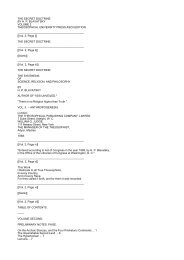Create successful ePaper yourself
Turn your PDF publications into a flip-book with our unique Google optimized e-Paper software.
The Abode Of The Blessed.<br />
course along his mo<strong>the</strong>r's body, but sometimes a second female is represented bowed beneath Nut [1]<br />
(Fig. 2), and this is believed to signify <strong>the</strong> night sky across which <strong>the</strong> moon travels. In an interesting<br />
picture which M. Jéquier has published[2] <strong>the</strong> goddess is depicted lying flat with her arms stretched out<br />
at full length above her head; on her breast is <strong>the</strong> disk <strong>of</strong> <strong>the</strong> sun, and on her stomach <strong>the</strong> moon. Those<br />
who believed that <strong>the</strong> sky was an iron plane imagined that <strong>the</strong> stars were a numbers <strong>of</strong> lamps which were<br />
hung out <strong>the</strong>refrom, and those who pictured <strong>the</strong> sky as a goddess studded her body with stars. One scene<br />
makes <strong>the</strong> morning and evening boats <strong>of</strong> Ra to sail along <strong>the</strong> back <strong>of</strong> Nut;[3] ano<strong>the</strong>r depicts Shu holding<br />
up <strong>the</strong> boat <strong>of</strong> <strong>the</strong> sun wherein is <strong>the</strong> disk on <strong>the</strong> horizon.[4] A third from <strong>the</strong> sarcophagus <strong>of</strong> Seti I.<br />
represents Nu <strong>the</strong> god <strong>of</strong> <strong>the</strong> primeval water holding up <strong>the</strong> boat <strong>of</strong> <strong>the</strong> sun, wherein we see <strong>the</strong> beetle<br />
with <strong>the</strong> solar disk facing it accompanied by Isis and Nephthys, who stand one on each side; behind Isis<br />
stand <strong>the</strong> gods Seb, Shu, Hek, Hu, and Sa, and behind Nephthys are three deities who represent <strong>the</strong> doors<br />
through which <strong>the</strong> god Tmu has made his way to <strong>the</strong> world.[5]<br />
The Tuat, or abode <strong>of</strong> <strong>the</strong> dead.<br />
Within <strong>the</strong> two bowed female figures which represent <strong>the</strong> day and <strong>the</strong> night sky, and which have been<br />
referred to above (Fig. 2), is a third figure which is bent<br />
[1. Lanzone, op. cit., tav. 155.<br />
2. Le Livre de ce qu'il y a dans l'Hadès, p. 3<br />
3 Ibid., tav. 157.<br />
4. Ibid., tav. 158.<br />
5 Brugsch, Religion und Mythologie, p. 216.]<br />
{p. civ}<br />
The Egyptian heaven.<br />
round in a circle; <strong>the</strong> space enclosed by it represents according to Dr. Brugsch <strong>the</strong> Tuat[1]or Egyptian<br />
underworld, wherein dwelt <strong>the</strong> gods <strong>of</strong> <strong>the</strong> dead and <strong>the</strong> departed souls. This view is supported by <strong>the</strong><br />
scene from <strong>the</strong> sarcophagus <strong>of</strong> Seti I. (Fig. 1). In <strong>the</strong> watery space above <strong>the</strong> bark is <strong>the</strong> figure <strong>of</strong> <strong>the</strong> god<br />
bent round in a circle with his toes touching his head, and upon his head stands <strong>the</strong> goddess Nut with<br />
outstretched hands receiving <strong>the</strong> disk <strong>of</strong> <strong>the</strong> sun.[2] In <strong>the</strong> space enclosed by <strong>the</strong> body <strong>of</strong> <strong>the</strong> god is <strong>the</strong><br />
legend, "This is Osiris; his circuit is <strong>the</strong> Tuat."[3] Though nearly all Egyptologists agree about <strong>the</strong><br />
meaning <strong>of</strong> <strong>the</strong> word being "<strong>the</strong> place <strong>of</strong> departed souls," yet it has been translated in various ways,<br />
different scholars locating <strong>the</strong> Tuat in different parts <strong>of</strong> creation. Dr. Brugsch and o<strong>the</strong>rs place it under<br />
<strong>the</strong> earth,[4] o<strong>the</strong>rs have supposed it to be <strong>the</strong> space which exists between <strong>the</strong> arms <strong>of</strong> Shu and <strong>the</strong> body<br />
<strong>of</strong> Nut,[5] but <strong>the</strong> most recent <strong>the</strong>ory put forth is that it was situated nei<strong>the</strong>r above nor below <strong>the</strong> earth,<br />
but beyond Egypt to <strong>the</strong> north, from which it was separated by <strong>the</strong> mountain range which, as <strong>the</strong><br />
Egyptians thought, supported <strong>the</strong> sky.[6] The region <strong>of</strong> <strong>the</strong> Tuat was a long, mountainous, narrow valley<br />
with a river running along it; starting from <strong>the</strong> east it made its way to <strong>the</strong> north, and <strong>the</strong>n taking a circular<br />
direction it came back to <strong>the</strong> east. In <strong>the</strong> Tuat lived all manner <strong>of</strong> fearful monsters and beasts, and here<br />
was <strong>the</strong> country through which <strong>the</strong> sun passed during <strong>the</strong> twelve hours <strong>of</strong> <strong>the</strong> night; according to one<br />
view he traversed this region in splendour, and according to ano<strong>the</strong>r he died and became subject to Osiris<br />
<strong>the</strong> king, god and judge <strong>of</strong> <strong>the</strong> kingdom <strong>of</strong> <strong>the</strong> departed.<br />
The Fields <strong>of</strong> Aaru and Hetep.<br />
http://www.sacred-texts.com/egy/ebod/ebod08.htm (2 <strong>of</strong> 4) [8/10/2001 11:23:43 AM]

















